Discovering the Varied Types of Waffles
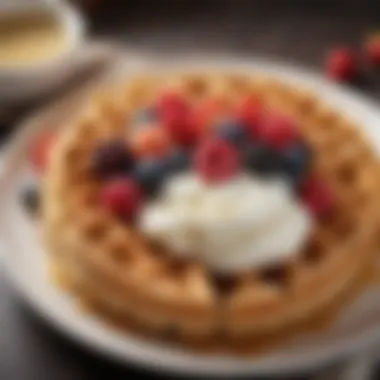
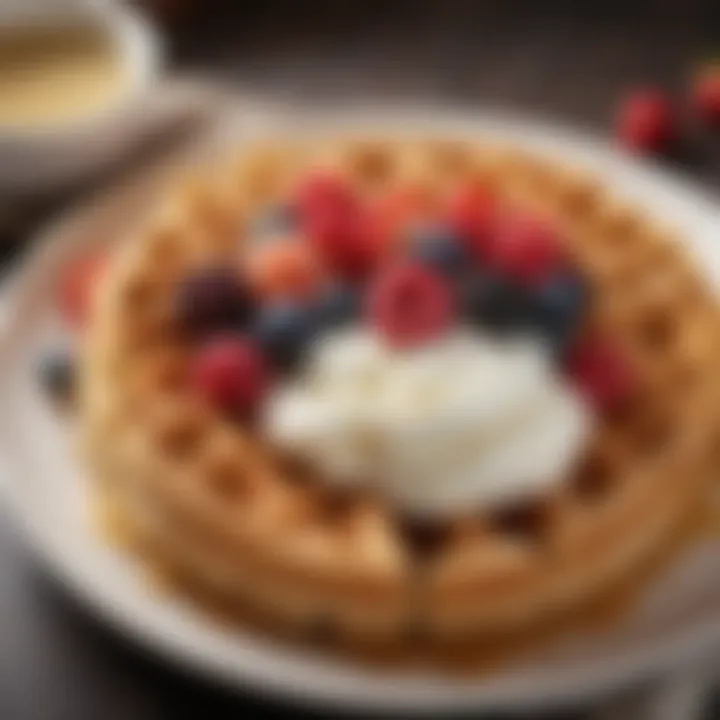
Intro
Waffles, those delectable creations that have captivated the hearts and taste buds of many, come in a variety of forms that reflect cultural nuances and regional traditions. Each type of waffle carries with it a story, a touch of history, and a dash of flavor that sets it apart. With origins tracing back centuries, the evolution of waffles encompasses not only their preparation methods but also their significance within different cuisines.
From the airy, golden Belgian waffle to the chewy, pocket-filled Hong Kong egg waffle, there is an undeniable charm and appeal that each style possesses. These aren't just breakfast foods; they serve as canvas for a plethora of toppings and an ideal base for culinary experimentation, appealing to both traditionalists and adventurous eaters alike. The exploration of waffles isn’t just a culinary journey, but a cultural experience that invites an understanding of flavors, textures, and local adaptations.
In the following sections, we will delve deeper into the unique characteristics of various waffle types. We will also explore innovative toppings, fillings, and ways to enjoy these mouthwatering creations. The ultimate goal is to equip food lovers and home cooks with insights that inspire creativity in their kitchens, bringing this universal delight to life in diverse and exciting forms.
Prelims to Waffles
Waffles have carved out a delightful niche in the culinary world, serving as more than just a breakfast item. They present unique opportunities for creativity in cooking and presentation. Understanding their origins gives food lovers insight into regional variations, the evolution of flavors, and even the cultural stories woven into each bite. A detailed exploration creates a deeper appreciation for this seemingly simple dish.
Historical Context
Waffles have a rich history that dates back to the Middle Ages, where they first appeared in Europe. Initially, people made them using two metal plates heated over a fire, producing a crisp treat with a distinctive pattern. The earliest documented mention of waffles can be traced to the 9th century, long before they found their way to America. Back then, they were referred to as "gaufres" in France, a term that reflects the honeycomb-like structure these treats often have.
Throughout the centuries, these delicacies evolved, making their way through different cultures. For instance, it was in Brussels where the Belgian variety gained prominence, characterized by its light and fluffy texture. The introduction of baking powder in the 19th century led to a major shift in waffle making, allowing for variations that cater to various tastes and preferences.
"From medieval kitchens to modern brunch menus, waffles have transformed, yet their essence remains—a simple pleasure with a storied past."
Culinary Significance
The culinary significance of waffles extends beyond their taste. They serve as a blank canvas for a diverse array of toppings and accompaniments. From maple syrup and whipped cream to savory toppings like fried chicken or avocado, the flexibility of waffles allows for endless experimentation.
Including waffles in one's diet can also reflect broader culinary trends, like the rise of breakfast-for-dinner dishes. Their versatility makes them suitable for any meal of the day, making them an appealing option for both home cooks and food enthusiasts.
Moreover, the recent boom of gourmet waffle food trucks and pop-up cafes showcases their growing appeal. Chefs and home bakers alike experiment with exotic ingredients and innovative flavor profiles, emphasizing waffles' ability to adapt.
In essence, waffles not only satisfy hunger but also act as a cultural exchange platform where traditions meet modernity, offering delightful experiences for both the palate and the mind.
Classic Waffle Varieties
Classic waffles serve as the cornerstone of this culinary exploration. They establish a rich framework that honors tradition while leaving room for innovation. The beauty of these varieties is that they are not only delicious but also versatile, catering to the palette of different cultures and individual preferences. Diving into Belgian and American waffles unveils a blend of history, texture, and flavor that can satisfy any craving.
In the grand scheme of things, understanding the classic types of waffles allows enthusiasts and home cooks alike to appreciate the nuances that make each type unique. It’s not just about the waffle itself, but how the traditional methods and ingredients intermingle to create a cherished dish that spans generations.
Belgian Waffles
Belgian waffles are perhaps the celebrities of the waffle world, immediately recognizable by their deep grid pattern and fluffy texture. Their popularity skyrockets thanks to their adaptability in toppings and flavors offered.
Syrup and Topping Options
When it comes to syrup and toppings, Belgian waffles are a blank canvas just waiting to be adorned with a variety of flavors. From the classic maple syrup, drizzling elegantly down the golden-brown surface, to fresh berries that burst with sweetness, the choices are endless. The key characteristic of these toppings is that they enhance the waffle experience, balancing texture and flavor beautifully.
A standout feature is whipped cream, adding a lightness that far removes the waffle from a simple breakfast item into a delightful treat. However, while the sweet options dominate the scene, there’s a growing trend of savory toppings too, like fried chicken or bacon, proving just how adaptable these waffles can be.
This versatility in syrup and topping options makes Belgian waffles a beneficial choice for both breakfast lovers and dessert enthusiasts alike.
However, one must be cautious; the abundance of sweet toppings may overshadow the waffle’s natural flavor if not chosen wisely.
Variations and Twists
Variations and twists on the classic Belgian waffle are another reason this dish remains a culinary staple. Adapting ingredients—like replacing traditional all-purpose flour with almond flour—has opened up avenues for gluten-free options, while combining spices such as cinnamon or cardamom adds a unique flair.
A notable characteristic of these variations is the integration of cultural traditions, such as incorporating matcha, which has piqued interest among health-conscious foodies.
The distinct feature of the Belgian waffle is its thick, airy structure that holds toppings exceptionally well, creating bursts of flavor in every bite. Though, one drawback to consider is that overly experimental variations can stray too far from the original recipe, possibly leading to discontent among purists.
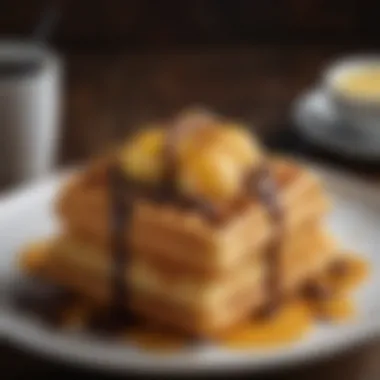
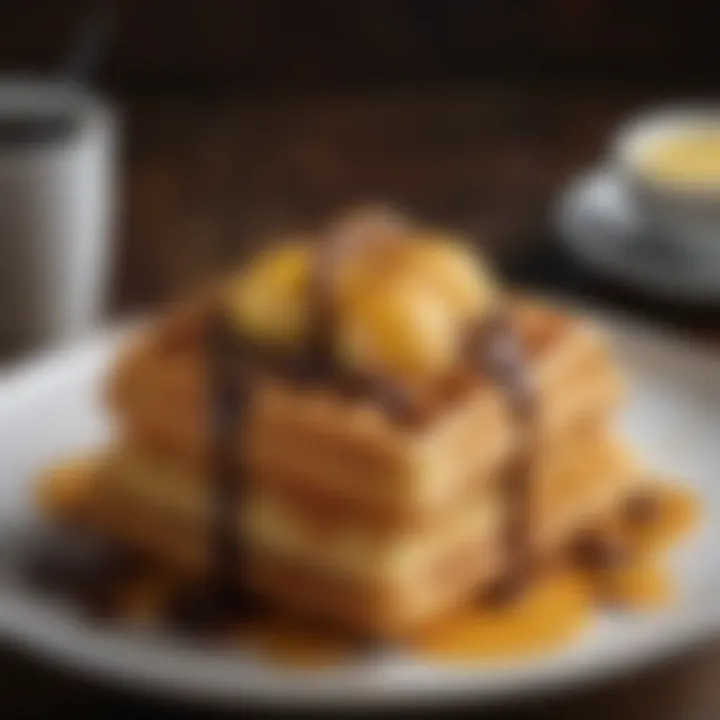
American Waffles
American waffles provide a different take, distinct for their thinner, denser profile when compared to their Belgian counterparts. This variation caters more to those desiring a heartier texture that can support robust toppings.
Texture and Flavor Differences
The texture and flavor differences are stark between American and Belgian waffles. American waffles tend to be denser and crispier, owing to a batter typically higher in fat content, often featuring more sugar. This characteristic allows the waffle to be a filling option, perfect for a satisfying meal.
American waffles boast a versatility that lends themselves well to synergy with a range of foods, from sweet to savory. The crispy edges combined with that buttery flavor offer a familiar comfort.
"The unique texture plays a pivotal role in elevating mealtime encounters, whether it’s breakfast or brunch."
However, this density can sometimes create an overwhelming experience if over-topped, leaving less room for flavors to shine through.
Typical Accompaniments
Typical accompaniments for American waffles often include rich options like fried chicken or eggs, transforming a simple breakfast into an entire feast. The defining feature lies in how these accompaniments turn the waffle from a mere breakfast item into a complete dish that satisfies various taste preferences.
American waffles also welcome diverse toppings: think whipped butter melting into the crevices or a drizzle of chocolate sauce for those with a sweet tooth. This variety makes the waffles appealing to a broad audience, though the heavier approach can deter some from indulging at any time other than breakfast.
The classic waffle varieties, thus, are not merely regional delicacies; they symbolize cultural identities, evolving continuously while remaining rooted in tradition. They offer a gateway into the heart of what makes waffles a beloved dish in so many cuisines.
International Waffle Types
The world of waffles stretches beyond the familiar outlines of Belgian and American varieties, offering a plethora of unique and diverse waffle types that reflect cultural richness and culinary creativity. This section delves into the remarkable international varieties, shedding light on their ingredients, cooking methods, and the cultural significance they carry. Understanding these waffles provides food enthusiasts and home cooks alike with inspiration for exploring new flavors and experiences in their culinary pursuits.
Liège Waffles
Distinctive Features
Liège waffles are a real treat, known for their dense, chewy texture and caramelized sugar pockets that come from pearls of sugar. This waffle type is not just about taste; its unique characteristics contribute to a delightful eating experience. The dough is made with yeast rather than batter, giving it a bread-like quality that many find irresistible. This makes them a popular choice for those who appreciate depth in flavor. The sugar caramelizes quickly when cooked, leading to a crispy exterior, which contrasts beautifully with its soft inside.
One unique aspect worth noting is how these sugar crystals melt during cooking, creating a crispy shell while preserving the interior's moistness. However, this distinctive preparation can be tricky; not every cook can master the perfect balance without burning the sugar.
Cooking Techniques
When it comes to cooking Liège waffles, the process is as crucial as the ingredients used. Traditionally, they're made in a specific iron that allows for the dough to rise and the sugar to caramelize properly. This technique ensures that the baroque, irregular shapes typical of Liège waffles develop their wonderful contrast of textures.
An interesting feature of this cooking method is that it often includes preheating the waffle iron to a high temperature. This helps in achieving that perfectly cooked waffle, though it can be a little challenging for beginners to get the timing right. Those eager to try their hand at making Liège waffles may find the learning curve quite rewarding, but patience is key to avoid any mishaps with the sugar.
Hong Kong Egg Waffles
Cultural Relevance
Hong Kong egg waffles are much more than just a snack; they're steeped in local culture and tradition. Originating from the bustling markets of Hong Kong, these waffles are a playful take on traditional Western waffles, featuring a light, airy texture and a distinctive eggy flavor. The unique bubble shape makes them a fun food, perfect for street eats. They often evoke nostalgia among locals, reminding them of childhood treats. This cultural significance lies not only in their flavors but also in the way they encapsulate the spirit of Hong Kong’s lively food scene.
In addition to their local roots, these waffles have been adopted worldwide, showcasing the global trend of fusion cuisine, but the authentic experience of enjoying them fresh from a street vendor on a busy Hong Kong street is truly unparalleled.
Modern Innovations
Today, the appeal of Hong Kong egg waffles extends beyond their traditional forms, with a wave of modern innovations transforming how they are served. Creative fillings and toppings have emerged, ranging from matcha ice cream to fresh fruit and whipped cream, making them more appealing to a wider market. These innovations invite food lovers to experiment, combining different flavors and styles, pushing the limits of traditional waffle experiences.
The key benefit of these modern adaptations is the ability to customize egg waffles according to personal tastes. With the rise of social media, these creative presentations have become a hit online, bringing even more excitement and attention to this delightful dish. However, while exciting, some traditionalists argue that this could detract from the authenticity of the classic recipe.
Finnish Pannukakku
Variations Across Finland
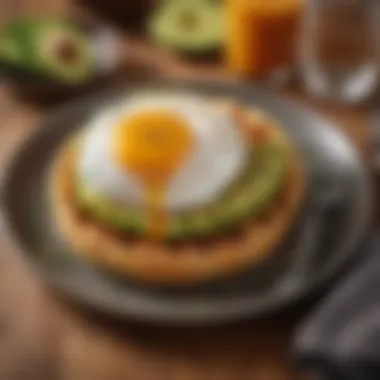
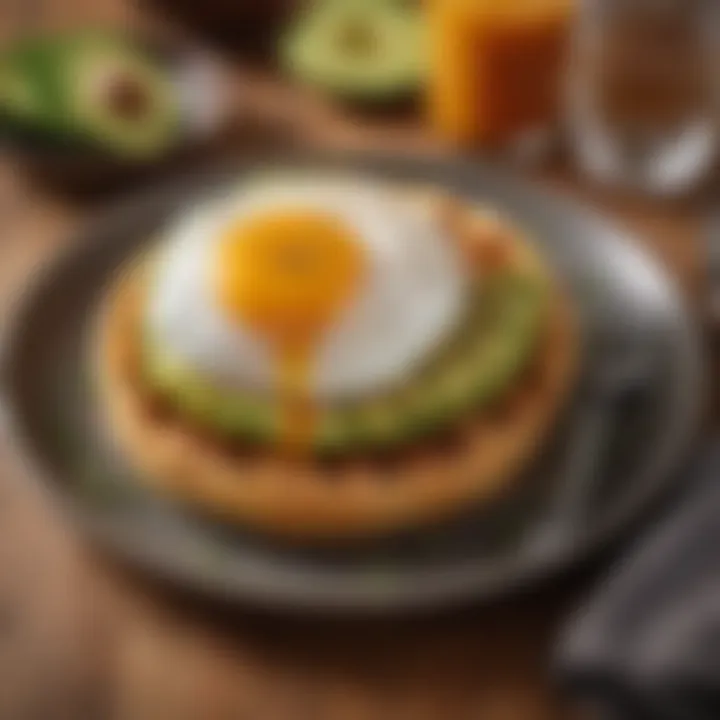
Finnish pannukakku, or "pan pancake," is worth exploring, as it showcases delightful variations unique to different regions of Finland. Unlike the standard waffle, this dish is baked in the oven and served as a thick, fluffy pancake cut into squares or wedges. In various parts of Finland, you might find different flavorings, such as cardamom or vanilla, added into the batter, offering a special twist. This versatility makes the dish an inviting choice for families seeking something delicious for breakfast or brunch.
However, it often requires an oven-safe pan, which may limit the technique's accessibility. But for those equipped with the right tools, the results are simply delightful, presenting a versatile base for any toppings, both sweet and savory.
Serving Suggestions
When it comes to serving Finnish pannukakku, the options appear endless. Traditionally, it's enjoyed with jam, whipped cream, or fresh berries, but there’s no stopping creativity in this department. As it serves as a great base, you can even top it with savory items like smoked salmon or cheese for a twist on breakfast.
This versatility is a significant advantage, allowing cooks to cater to diverse palates and adapt it for occasions, making it perfect for both casual brunch gatherings and formal settings. However, when serving, it's essential to consider portion sizes, as the fluffy nature of the batter can be deceivingly filling.
Unique Waffle Preparations
Unique waffle preparations are crucial in expanding our understanding of this versatile dish. They not only showcase creativity but also adapt to various cuisines and preferences. As we dive into savory and dessert waffles, it is important to recognize that waffles can be more than just breakfast. They can embody diverse flavors, textures, and ingredients, making them a suitable choice for any meal of the day.
Savory Waffles
Savory waffles offer an interesting twist to the traditional sweet variety. They have gained popularity for their ability to incorporate a range of dinner-influenced ingredients, making them a fantastic option for brunch or dinner.
Ingredients and Combinations
When we talk about ingredients and combinations in savory waffles, we often think of elements that can compliment the more traditional breakfast flavors. Cheese, herbs, and spices are commonly used, providing depth and richness. For example, using feta cheese and spinach introduces a Mediterranean flair, while adding jalapeños can give a kick of heat.
This makes savory waffles a beneficial choice for anyone looking to break away from routine meals. The unique feature of savory waffles lies in their adaptability; you can easily swap in or out flavors based on dietary needs or personal preferences. However, it’s worth noting that while sweet waffles might appeal to a broader audience, savory options can sometimes require an acquired taste. Leading into a savory waffle dish is often a delightful surprise, even for the skeptics.
Serving Ideas
Serving ideas for savory waffles open a realm of possibilities. Pairing them with a poached egg or a dollop of crème fraîche can elevate the dish while keeping it simple. The key characteristic here is versatility; you can serve savory waffles as a stand-alone dish or as a base for other toppings such as pulled pork, or even salad, lending a unique texture and flavor to the meal. What sets these serving options apart is the ability to integrate waffles into diverse meal types. However, one drawback could be that certain toppings might overshadow the waffle itself, making it essential to find the right balance. Hence, thoughtful pairings are necessary to fully highlight what a savory waffle can offer.
Dessert Waffles
Dessert waffles are the sweet sister of savory ones and play a major role in highlighting the indulgent side of waffle preparations. These creations usually come alive with flavor and visual appeal.
Chocolate and Fruit Infusions
Chocolate and fruit infusions can redefine the takes on waffles, providing exciting ways to enjoy this dish in a sweet context. Incorporating melted chocolate or rich cocoa in the batter allows for a gooey, decadent experience. Adding fruits like strawberries or bananas not only makes the waffle taste delicious but also adds a burst of natural sweetness and color. Chocolate and fruit options are popular because they cater to both kids and adults, merging nostalgia with a modern twist. The unique feature here lies in their ability to evoke comfort and joy. While these combinations are often crowd-pleasers, keep an eye on portion size—too much sweetness can overwhelm the palate or lead to an unbalanced dish.
Creative Topping Choices
Creative topping choices for dessert waffles can range from traditional maple syrup to more adventurous options like matcha cream or caramelized pineapple. This flexibility enhances the overall eating experience and encourages experimentation with contrasting flavors and textures. One of the standout attributes of these toppings is their capacity to blend the familiar with the exotic; for example, a spicy chocolate drizzle paired with a cooling mint yogurt can delight the senses. A drawback can be the process of finding toppings that complement each other, as not every combination will reach the perfect harmony. Ensuring a cohesive dish sometimes requires more effort, but when achieved, it can be a truly satisfying endeavor.
Ultimately, unique waffle preparations are not just about diversifying meals; they encourage creativity in the kitchen and celebration of flavors that delight.
Health-Conscious Waffles
The notion of health-conscious eating has gained traction in recent years. As people become more aware about their diet, waffles are no longer just a sweet treat; they can now fit into a healthier lifestyle. It becomes crucial to explore how waffles can be adapted to cater to those seeking healthier options, whether due to dietary restrictions or lifestyle choices. This section dives into gluten-free options and low-calorie variations, shedding light on how we can enjoy waffles without sacrificing our health.
Gluten-Free Options
Flour Substitutes
When thinking of gluten-free waffles, one might consider alternatives like almond flour, coconut flour, or chickpea flour. Each of these substitutes has a distinct feature that makes them appealing. Almond flour, for instance, is rich in protein and healthy fats, which helps in creating a waffle that’s not only light but satisfying. 🥘 Coconut flour, on the other hand, is absorbent, which means it requires more liquid in the recipe, but it offers a hint of sweetness and great fiber content. These substitutes become beneficial choices in making waffles inclusive and accessible for those with gluten sensitivities.
Yet, they also come with their own sets of challenges. For example, using coconut flour excessively can lead to a drier texture, while almond flour may not rise as much as traditional wheat flour. Finding the right balance is essential.
Texture Considerations
Texture is always a pivotal aspect when it comes to waffle preparation. Gluten typically gives baked goods their structure and chewy texture, and lacking it means one needs to compensate using other methods. To achieve that delightful crisp on the outside and fluffiness inside, many recipes call for added eggs or baking soda. The key characteristic here is to experiment with ratios until finding that sweet spot where texture satisfies.
Interestingly, some cooks add ingredients like cornstarch or potato starch as they can enhance that light and airy quality. Achieving that right mouthfeel becomes a rewarding challenge, but it’s necessary to understand that results can differ based on the mix of gluten-free flours used. A trial and error approach might be needed to find what works best.

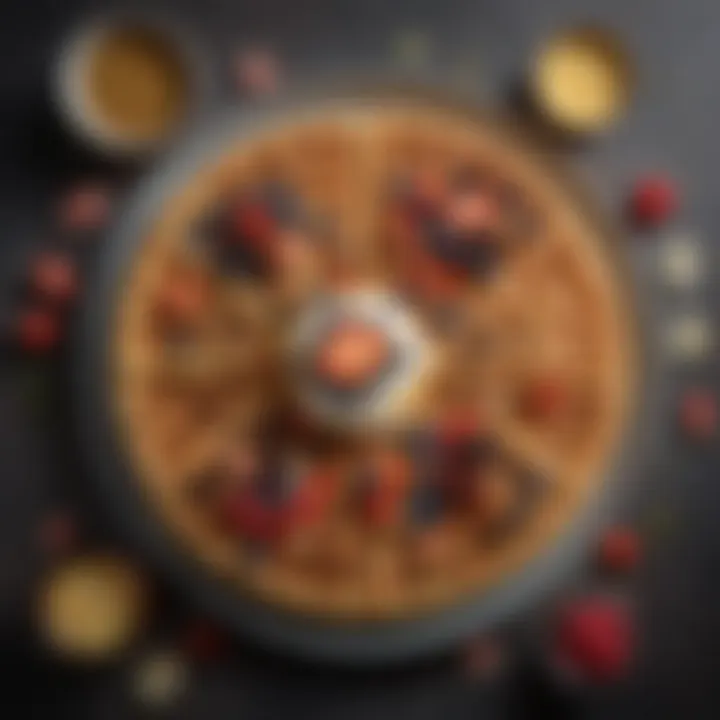
Low-Calorie Variations
Ingredient Swaps
In the quest for low-calorie waffles, many turn to ingredient swaps. By replacing refined sugars with natural sweeteners like mashed bananas or applesauce, one can cut down on calories while enhancing flavor. The standout point here is how these substitutes bring flavor and moisture without piling on the calories.
Moreover, using Greek yogurt in place of oil or butter adds creaminess and protein without the excess fat. However, it's crucial to note that not all substitutes yield the same taste. A swap might texturally work but could end up altering the traditional waffle experience. It's all about finding that balance for acceptable flavor without overindulgence.
Nutritional Balance
Nutritional balance is another vital aspect when crafting waffles that are both low in calories and satisfying. Attention must be paid to the ingredients to ensure that the waffles are not just fillers but also provide some nourishment. Opting for whole-grain flour over regular flour contributes fiber, and incorporating fruits boosts vitamins.
What’s particularly appealing about maintaining nutritional balance is the flexibility it offers. By adding a scoop of protein powder, for instance, one can enhance the serving’s protein and help in muscle repair. However, this must be balanced against potential dry-out of the waffles.
Ultimately, achieving health-conscious waffles is about compromise and creativity. The goal is to enjoy the essence of waffles without guilt.
Embracing healthy living does not necessitate sacrificing taste; it's about reimagining recipes, making thoughtful choices, and thinking outside the box.
Waffles in Contemporary Cuisine
Waffles have undergone a remarkable transformation in the culinary world, becoming more than just a breakfast staple. In contemporary cuisine, they hold a prestigious spot on menus across the globe. From savory offerings to sweet indulgences, the evolution of waffles reflects changing tastes and diverse cultural influences. This section highlights the significant role of waffles in modern gastronomy, shedding light on trends, creative recipes, and interesting food fusions that captivate food enthusiasts.
Fusion Waffle Recipes
Cross-Cultural Influences
One of the cornerstones of modern waffle cuisine is its adaptability to various cultural influences. Cross-cultural collaborations have resulted in innovative dishes that push the boundaries of traditional waffle-making. For instance, think about a Thai-inspired waffle made with coconut milk and served with mango chunks and sticky rice. This reflects a melding of flavors that not only tempts the palate but also tells a story of cultural exchange.
The incorporation of spices and ingredients from other cuisines creates a unique characteristic that is becoming increasingly popular in this article. It is worth noting that this diverse twist on waffles is not just a trend but a delightful approach to making meals more exciting. A major advantage of these recipes is their ability to cater to adventurous diners and offer them something out of the ordinary. However, one possible disadvantage is that not all flavor combinations may resonate with a broader audience, making it essential to know the target market well.
Experimental Flavors
Contemporary cuisine is all about creativity, and with waffles, it’s no different. Experimental flavors have taken center stage in many dining establishments, offering exciting alternatives to traditional toppings. Think of matcha-infused waffles topped with lavender crème fraiche or a chili chocolate syrup drizzled over a classic Belgian waffle. The use of such unconventional flavors adds complexity and intrigue to the dining experience.
This particular aspect of experimental flavors underscores the growing trend of culinary experimentation, appealing to foodies eager to try new combinations. The standout feature of these recipes is that they cultivate a sense of surprise, challenging taste buds and encouraging guests to step outside of their usual culinary comfort zones. However, one needs to approach this with caution, as not every flavor mash-up will be a winner. Balancing boldness with palatability is vital for success.
Waffle Food Trends
Social Media Influence
Social media has substantially impacted the food industry, and waffles are no exception. Platforms like Instagram and Pinterest are awash with aesthetically pleasing waffle creations, making them a perfect subject for food photography. This has propelled waffles into the spotlight, leading to an abundance of creative recipes and presentation styles.
The visual appeal of these dishes encourages sharing among food enthusiasts, resulting in significant traction for waffle-related content. The key characteristic of this trend is that it drives restaurants to innovate, creating Instagram-worthy dishes that attract diners looking for that perfect post. While this has undoubtedly expanded the waffle's popularity, it can also lead to a scenario where the emphasis on looks overshadows flavor. Maintaining a balance between appearance and taste becomes crucial.
Pop-Up Waffle Shops
There’s no turning a blind eye on the rise of pop-up waffle shops, a phenomenon that has been gaining momentum in urban centers. These temporary culinary hotspots showcase a variety of waffle creations that often reflect local flavors or seasonal ingredients. The lively atmosphere of a pop-up shop adds to the overall dining experience, making it more memorable for patrons.
Pop-up waffle shops highlight the key characteristic of versatility, allowing chefs to experiment without the long-term commitment of traditional restaurant models. This flexibility provides a platform for creativity and trend experimentation. However, the challenges include the transient nature of pop-ups, which might limit customer loyalty. It’s important for these shops to capitalize on their time in the spotlight and make a lasting impression on their visitors before they move on.
Closure
As we wrap up our exploration of waffles, it’s clear that these beloved treats hold a special place in the culinary landscape across the globe. The variety of waffle types discussed — from the classic Belgian to the unique Hong Kong egg waffles — each offer distinctive flavors and textures. This diversity not only reflects regional tastes but also cultural influences, showcasing how a simple batter transformed into a crispy, golden delight becomes intertwined with local traditions.
In the modern kitchen, waffles are far more than just a breakfast item. They’ve morphed into a canvas for culinary artistry, inviting chefs and home cooks alike to get creative. As we look to the future, the integration of global flavors into waffle recipes encourages experimentation and invites food lovers to step out of their comfort zones. Think savory toppings with a dash of spice or dessert waffles layered with exotic fruits. The possibilities are limited only by one’s imagination.
Waffles also sit at the intersection of health and indulgence. With health-conscious versions of this classic food popping up, like gluten-free and low-calorie variations, they provide an opportunity to enjoy oneself without the accompanying guilt. This is particularly appealing for those who are trying to balance their love for sweets with nutritional needs.
"Waffles are not just food; they are a reflection of who we are culturally and personally."
The future is bright for waffles. The rise of social media has not only broadened the palette of flavor combinations but has also fostered a community where home cooks share their favorite recipes and waffle hacks. Over the years, pop-up shops focusing specifically on waffles have gained traction, proving that this humble dish has maintained its relevance in contemporary cuisine.
As you consider your next meal, don’t just think of waffles as a treat but as an opportunity to connect with diverse flavors and experiences. Embrace the waffle — a versatile symbol of comfort and creativity.







